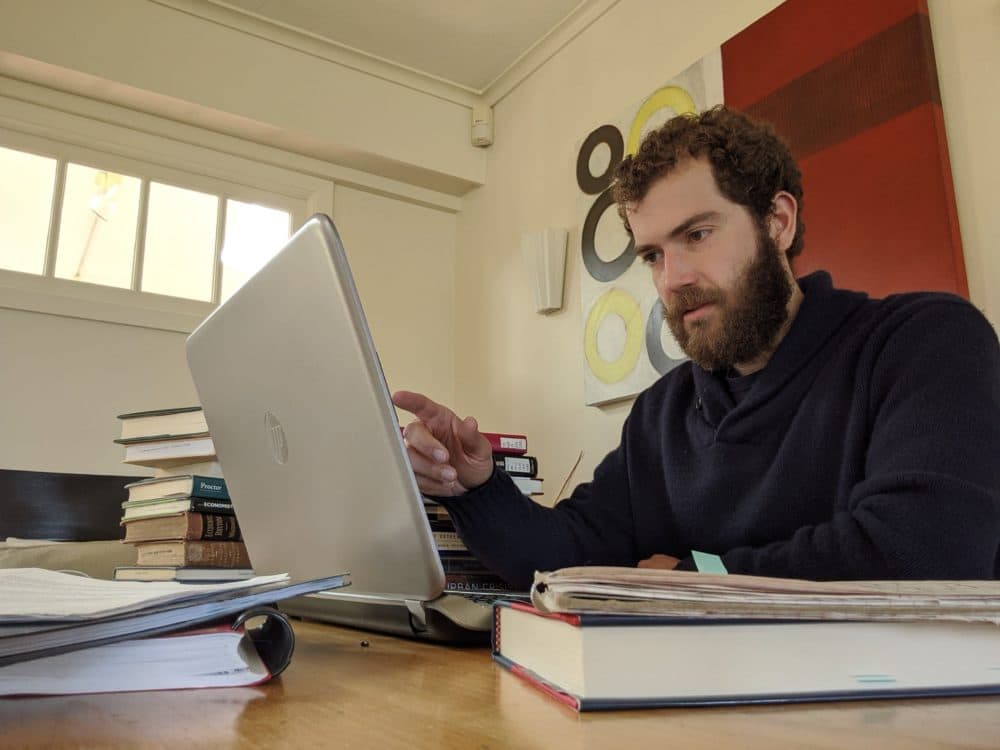Advertisement
For Students And Professors, Remote Learning Is No Substitute For Being On Campus

Harvard sophomore Ria Modak lives in the epicenter of the coronavirus pandemic, near several of New York City's major hospitals.
"So I'm often filled with what I've begun to call existential dread and a lot of anxiety," she said.
She hears sirens constantly. Both her parents are doctors working in hospitals, and some of their patients have COVID-19. Her father does rounds on all the COVID patients in the pediatric department at his hospital.
"[I'm] fearing for their safety, fearing for my own community in New York," Modak said.
That has made it extremely difficult to focus on studies.
"It seems like school just cannot and should not be a priority when people in my building, people in my neighborhood and my community are falling sick," she said.
Modak is trying to keep up with her courses. Several are seminars with eight to ten people. Those classes are all about the discussions — even on video-conferencing platforms like Zoom.
"The quality of conversation is generally a bit lower," Modak said. "There's a lot of confusion that tends to happen with Zoom. People cut out often."
"Teaching on Zoom is just an absolute shadow of teaching in real life"
Max Ehrenfreund, Harvard graduate teaching fellow
Modak feels fortunate that she has access to WiFi and lives in a safe home. But that's not the case for many of her classmates. Some have younger siblings or elderly relatives they take care of. Others have to work to support their families.
"Some students have started working when they returned home," Anthony Jack, an assistant professor of education at Harvard, said. "Whether it's doing things like deliveries, working in grocery stores, applying [for] and working in essential worker positions."
Jack, himself a first-generation college student, said that as students were forced off campus, many who did not have broadband internet at home flocked to McDonald's and Starbucks for free WiFi, an option that quickly disappeared when restaurants were forced to close to the public.
Many professors worry that this semester will set some students back because of the challenges they face at home.
Advertisement
"Lower-income students do not do as well in online courses when compared to their higher-income peers," said Tolani Britton, an assistant professor of education at the University of California at Berkeley, whose work has focused on issues of access to higher education.
There are vast disparities in students' access to good WiFi connection that they need to be able to do their work.
"It's no substitute for in-person learning," said Harvard history professor Kirsten Weld, who is teaching two courses remotely this semester.
Weld said many students who are back living at home don't have access to a private space where they can close the door and have quiet and fully concentrate on the class that they're participating in remotely.
"They're sitting at the dining room table and there are family members in the background or kids running by," Weld said.
She said there are also all the new responsibilities that many students have. Some are being conscripted into full-time child care for younger siblings or care for grandparents. Others are trying to keep their family business going.
Weld said some students in her classes have written to her and to her teaching fellows to say that they are now the primary breadwinner for their family because both of their parents have been laid off. She has students in rural areas who don't have broadband access.
What she's seeing as an educator is that it is impossible to turn a blind eye to the immense scale of the inequities that students are facing. Then, there are health issues.
"I've already had four or five students who have written me to say they've not been able to get tested but they've had a roommate or a family member who has tested positive [for the coronavirus] and so doctors have told them that they are presumed positive," Weld said. "So they have lost a week or two of being able to keep up with things because they are physically ill."
In one of her courses, Weld has made the research paper optional.
"What's been sacrificed is the amount of engagement and how creative you can get," said Brandon Mancilla, a third-year Ph.D. student at Harvard helping Weld teach one of her courses.
"What's been sacrificed is the amount of engagement and how creative you can get."
Brandon Mancilla, harvard phd student and teaching assistant
When students can't connect visually on Zoom, Mancilla said they don't feel they can participate fully. He's noticed more absences than he saw on campus.
"It's a challenge," said Max Ehrenfreund, another graduate teaching fellow at Harvard. "I was speaking with some of my fellow teaching fellows last night, and one of them said that teaching on Zoom is just an absolute shadow of teaching in real life, and that's absolutely true."
Both of the courses Ehrenfreund is teaching are lectures, which he's now teaching from his home in Oregon.
Ehrenfreund said the material had to be redesigned. It's hard to get a discussion going on Zoom with 15 or more students, he said, so he asks students to work in groups of two or three.
When he is physically in a classroom, Ehrenfreund can see how students are responding and reacting. He can tell through their body language if they understand, and if they are interested in what he has to say.
He cannot really do any of that online. He just does not know. He sees their faces, but the quality is not very good and he cannot really see their postures. Many students don't have an internet connection that allows them to connect with video.
"That requires you to change your teaching," Ehrenfreund said. "It forces you to think differently about how you engage with the students. ... This whole experience has made me appreciate in a new way how important it is to actually be with students, because you can't just talk to them over a remote connection and hope that they're understanding what you're saying."
"This whole experience has made me appreciate in a new way how important it is to actually be with students, because you can't just talk to them over a remote connection and hope that they're understanding what you're saying."
Max Ehrenfreud, graduate teaching fellow
Modak, the Harvard student finishing her sophomore year in New York, has noticed much of the curriculum has changed, both because courses use Zoom and because the traditional grading scale has been switched to satisfactory or unsatisfactory.
"The curriculums have become a good deal less rigorous, which on the whole is a great thing for students who may be experiencing difficulties in their home life and may not be able to devote all of their energy to school," she said.
Despite the challenges, Modak calls remote learning the best response to an unfortunate situation.
"Even though, of course, the quality of the education is substantially lower," Modak said, "it feels like I've almost been cheated out of something. But that's what the reality is."
This article was originally published on April 20, 2020.
This segment aired on April 20, 2020.
